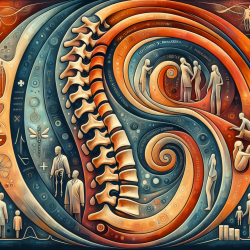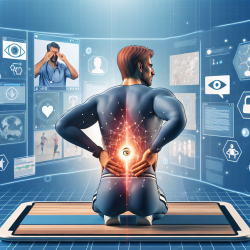In the realm of speech-language pathology, data-driven decisions are paramount, particularly when it comes to creating optimal outcomes for children. A significant aspect of this is understanding and integrating the latest research into clinical practice. One such crucial research is the findings from the 13th International Conference on Conservative Management of Spinal Deformities and the First Joint Meeting of the International Research Society on Spinal Deformities and the Society on Scoliosis Orthopaedic and Rehabilitation Treatment (SOSORT-IRSSD 2016). This conference provided valuable insights that can enhance practitioner skills in managing spinal deformities, particularly scoliosis, in children.
The study titled "The reliability of the three-dimensional spinal modeling of patients with adolescent idiopathic scoliosis using EOS system" presented at the conference, underscores the importance of advanced imaging techniques. The EOS imaging system offers low radiation exposure and precise 3D spinal modeling, which is crucial for accurate diagnosis and treatment planning. The research demonstrated excellent reproducibility for Cobb angles and axial vertebral rotation, highlighting the system's reliability. For practitioners, this means that adopting the EOS system can lead to more accurate assessments and better treatment outcomes for children with scoliosis.
Moreover, the research on "Classification and agreement of sagittal balance and compensatory mechanics in younger and older adults with scoliosis" provides critical insights into the biomechanical aspects of spinal deformities. The study compared different lumbopelvic compensation equations and found significant differences between younger and older adults with scoliosis. For practitioners, understanding these differences is essential for tailoring treatment plans that consider the patient's age and specific biomechanical needs, thus enhancing the effectiveness of interventions.
Another noteworthy study, "Correlation between surface topography measurements and largest Cobb angle vary depending on adolescent idiopathic scoliosis curve type," emphasizes the importance of non-invasive surface topography in assessing scoliosis. The research revealed variable correlations between surface topography measurements and Cobb angles across different curve types. This finding suggests that practitioners should consider curve-specific approaches when using surface topography, thereby improving the accuracy of scoliosis assessments and the customization of treatment plans.
Furthermore, the conference highlighted the role of conservative treatments, such as bracing and physiotherapeutic scoliosis-specific exercises (PSSE). For instance, the study on "Upright, prone and supine spinal morphology in adolescent idiopathic scoliosis" explored the impact of different postures on spinal morphology. This research supports the use of PSSE in conjunction with bracing to enhance treatment outcomes. Practitioners can leverage these insights to implement more effective, multi-faceted treatment strategies that address the unique needs of each child.
Additionally, the importance of continuous monitoring and adjustments in treatment plans was underscored by the research on "Radiation dose of digital radiography (DR) versus micro-dose x-ray (EOS) on patients with adolescent idiopathic scoliosis." The study found that the EOS system significantly reduces radiation exposure compared to conventional radiography, making it a safer option for long-term monitoring of scoliosis in children. Practitioners should consider integrating such low-dose imaging technologies to minimize radiation risks while ensuring accurate and frequent assessments.
In conclusion, the findings from the SOSORT-IRSSD 2016 conference offer valuable insights that can enhance the skills of practitioners in managing spinal deformities in children. By adopting advanced imaging techniques, understanding biomechanical differences, utilizing non-invasive assessment tools, and integrating conservative treatments, practitioners can improve the accuracy of diagnoses and the effectiveness of interventions. This, in turn, leads to better health outcomes for children with scoliosis. For a deeper dive into the original research, please follow this link: 13th International Conference on Conservative Management of Spinal Deformities and First Joint Meeting of the International Research Society on Spinal Deformities and the Society on Scoliosis Orthopaedic and Rehabilitation Treatment – SOSORT-IRSSD 2016.










